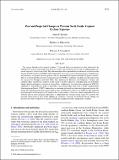| dc.contributor.author | Kossin, James P. | |
| dc.contributor.author | Camargo, Suzana J. | |
| dc.contributor.author | Emanuel, Kerry Andrew | |
| dc.date.accessioned | 2017-04-25T16:05:41Z | |
| dc.date.available | 2017-04-25T16:05:41Z | |
| dc.date.issued | 2016-07 | |
| dc.date.submitted | 2016-01 | |
| dc.identifier.issn | 0894-8755 | |
| dc.identifier.issn | 1520-0442 | |
| dc.identifier.uri | http://hdl.handle.net/1721.1/108396 | |
| dc.description.abstract | The average latitude where tropical cyclones (TCs) reach their peak intensity has been observed to be shifting poleward in some regions over the past 30 years, apparently in concert with the independently observed expansion of the tropical belt. This poleward migration is particularly well observed and robust in the western North Pacific Ocean (WNP). Such a migration is expected to cause systematic changes, both increases and decreases, in regional hazard exposure and risk, particularly if it persists through the present century. Here, it is shown that the past poleward migration in the WNP has coincided with decreased TC exposure in the region of the Philippine and South China Seas, including the Marianas, the Philippines, Vietnam, and southern China, and increased exposure in the region of the East China Sea, including Japan and its Ryukyu Islands, the Korea Peninsula, and parts of eastern China. Additionally, it is shown that projections of WNP TCs simulated by, and downscaled from, an ensemble of numerical models from phase 5 of the Coupled Model Intercomparison Project (CMIP5) demonstrate a continuing poleward migration into the present century following the emissions projections of the representative concentration pathway 8.5 (RCP8.5). The projected migration causes a shift in regional TC exposure that is very similar in pattern and relative amplitude to the past observed shift. In terms of regional differences in vulnerability and resilience based on past TC exposure, the potential ramifications of these future changes are significant. Questions of attribution for the changes are discussed in terms of tropical belt expansion and Pacific decadal sea surface temperature variability. | en_US |
| dc.description.sponsorship | National Science Foundation (U.S.) (Grants 1461517) | en_US |
| dc.description.sponsorship | United States. Office of Naval Research (Grant N000140910526) | en_US |
| dc.language.iso | en_US | |
| dc.publisher | American Meteorological Society | en_US |
| dc.relation.isversionof | http://dx.doi.org/10.1175/JCLI-D-16-0076.1 | en_US |
| dc.rights | Article is made available in accordance with the publisher's policy and may be subject to US copyright law. Please refer to the publisher's site for terms of use. | en_US |
| dc.source | American Meteorological Society | en_US |
| dc.title | Past and Projected Changes in Western North Pacific Tropical Cyclone Exposure | en_US |
| dc.type | Article | en_US |
| dc.identifier.citation | Kossin, James P., Kerry A. Emanuel, and Suzana J. Camargo. “Past and Projected Changes in Western North Pacific Tropical Cyclone Exposure.” Journal of Climate 29.16 (2016): 5725–5739. © 2016 American Meteorological Society | en_US |
| dc.contributor.department | Massachusetts Institute of Technology. Department of Earth, Atmospheric, and Planetary Sciences | en_US |
| dc.contributor.mitauthor | Emanuel, Kerry Andrew | |
| dc.relation.journal | Journal of Climate | en_US |
| dc.eprint.version | Final published version | en_US |
| dc.type.uri | http://purl.org/eprint/type/JournalArticle | en_US |
| eprint.status | http://purl.org/eprint/status/PeerReviewed | en_US |
| dspace.orderedauthors | Kossin, James P.; Emanuel, Kerry A.; Camargo, Suzana J. | en_US |
| dspace.embargo.terms | N | en_US |
| dc.identifier.orcid | https://orcid.org/0000-0002-2066-2082 | |
| mit.license | PUBLISHER_POLICY | en_US |
